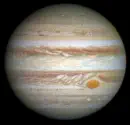
The force of gravity
This page contains a calculator for working out the force of gravity of two bodies in newtons (N) from the SI base units of
mass (kg) and distance (m). The formula is shown together with other useful information and examples to try.
Note that this equation only works when the bodies are sufficiently far apart. For the Earth and Moon it’s about a tenth of
their separation distance, therefore it will work in almost all situations we are likely to be interested in. Also, we need to
measure from the center of one mass (such as the center of the Earth) to the center of the other mass (such as the
center of the Moon). This is called the point mass, but for distant bodies it can usually be ignored.
The newton is a derived unit. Note that when written out fully the unit has a lower case n, i.e. newton, to distinguish it
from the person it is named after: Isaac Newton (1643 - 1727). However, the letter denoting the unit is upper case, i.e. N.
Enter all figures without commas. For example, enter 2,400 as 2400.
Calculate the force of gravity (N) of two masses (m
1
and m
2
)

The equation for gravity is given on the right.
Example: The Moon is mostly responsible for the changing tides on
Earth (the Sun also has an influence, but not as much). What is the force
of gravity exerted by the Moon on the Earth?
Firstly we will enter the mass of the Earth as m
1
. The mass of the Earth is
5.972 x 10
24
kg, so for m
1
we enter 5.972e24. Next, we enter the mass of
the Moon as m
2
.The mass of the Moon is 7.348 x 10
22
kg, so for m
2
we
enter 7.348e22.
The distance from center of the Earth to the center of the Moon is
384,500,000 m. Enter this as either 384500000 or 3.845e8. Now click
Calculate. Using the calculator we can see that the force of gravity
between the two bodies is 1.9811e+20 newtons or close to 2.0 x 10
20
N.
Of course, the Moon orbits the Earth and so tides are higher on
whichever part of the Earth it is nearest to during its orbit. The highest
tides, called spring tides, happen when the Sun, Moon and Earth are
aligned and occur approximately twice a month.


Where:
F = the force of gravity (newtons, N)
G = the gravitational constant:
6.6743 × 10
-11
N kg
-2
m
2
m
1
= mass of the first object (kg)
m
2
= mass of the second object (kg)
r
2
= the distance between the masses

Force of Gravity Calculator

The equation for the force of gravity is:
A couple of points to note:
If the Earth-Moon gravitational attraction is so strong why don’t
we feel it? It’s simply because the Moon’s pull is acting over the
whole Earth and everything on it. Individual people experience
just a very tiny share of it.
Gravity is actually a very weak force. For example, it only takes
about 1 newton to lift an apple up by about 1 meter. Another
way of thinking about it is that most people can pick up quite a
big bag of apples, even though the whole of Earth’s
gravitational pull is acting on it.


Some examples to try

Advertisement

Example 1: The speed of gravity is the same as the speed of light,
but as noted above the force of gravity is actually very weak, and it
becomes much weaker with distance.
To put this into perspective we can ask the question ”does Jupiter
affect the tides on Earth?”. The mass of Jupiter is 1.897 x 10
27
kg,
which is about 318 times the mass of the Earth (5.972 x 10
24
kg).
The closest Earth-Jupiter distance (when they are both on the same
side of the Sun) is 5.88 x 10
11
m (about 365 million miles).
Putting these figures into the calculator (m
1
= 1.897e27, m
2
=
5.972e24 and the distance is 5.88e11) and clicking Calculate tells us
that Jupiter does indeed have an affect on the Earth’s tides, but it’s
about 2,400 times weaker than the Moon’s and will therefore make
virtually no difference. Click Jupiter’s image for a larger picture:

Example 2: An article says that a comet twice the size of Halley’s Comet will make a close pass of Earth and cause
tidal waves, tsunamis and other disasters. Will it?
The mass of Halley’s comet is 2.2 x 10
14
kg so the figure we need to enter for m
1
is twice this: 4.4e14. For the Earth
(m
2
) we enter 5.972e24.
For the distance we will half the closest distance that Halley’s Comet is known to have ever approached Earth (about
5 million kilometers) in order to make the gravitational effect even stronger, so we enter 2500000000 m or 2.5e9.
Putting these figures into the calculator and clicking Calculate tells us that the comet’s gravitational affect on the
Earth will be around 1000 times weaker than that of the Moon. Therefore, it will have almost no affect on the Earth or
its tides.
This is something to remember next time you see a scary comet story on social media or in the news. Such stories
are almost as common as the comets themselves!
Quick Facts
Jupiter is the biggest planet in our
Solar System
It’s so big that over 1000 planet
Earths could fit inside it.


The Planet Jupiter
Advertisement




The force of gravity
This page contains a calculator for working out the force of
gravity of two bodies in newtons (N) from the SI base units of
mass (kg) and distance (m). The formula is shown together with
other useful information and examples to try.
Note that this equation only works when the bodies are
sufficiently far apart. For the Earth and Moon it’s about a tenth of
their separation distance, therefore it will work in almost all
situations we are likely to be interested in. Also, we need to
measure from the center of one mass (such as the center of the
Earth) to the center of the other mass (such as the center of the
Moon). This is called the point mass, but for distant bodies it can
usually be ignored.
The newton is a derived unit. Note that when written out fully the
unit has a lower case n, i.e. newton, to distinguish it from the
person it is named after: Isaac Newton (1643 - 1727). However,
the letter denoting the unit is upper case, i.e. N.
Enter all figures without commas. For example, enter 2,400 as
2400.
Calculate the force of gravity (N) of two masses (m
1
and m
2
)
The equation for gravity is given below.
Example: The Moon is mostly responsible for the changing tides
on Earth (the Sun also has an influence, but not as much). What
is the force of gravity exerted by the Moon on the Earth?
Firstly we will enter the mass of the Earth as m
1
. The mass of the
Earth is 5.972 x 10
24
kg, so for m
1
we enter 5.972e24. Next, we
enter the mass of the Moon as m
2
.The mass of the Moon is 7.348
x 10
22
kg, so for m
2
we enter 7.348e22.
The distance from center of the Earth to the center of the Moon is
384,500,000 m. Enter this as either 384500000 or 3.845e8. Now
click Calculate. Using the calculator we can see that the force of
gravity between the two bodies is 1.9811e+20 newtons or close
to 2.0 x 10
20
N.
Of course, the Moon orbits the Earth and so tides are higher on
whichever part of the Earth it is nearest to during its orbit. The
highest tides, called spring tides, happen when the Sun, Moon
and Earth are aligned and occur approximately twice a month.

Force of Gravity Calculator
A couple of points to note:
If the Earth-Moon gravitational attraction is so strong why
don’t we feel it? It’s simply because the Moon’s pull is
acting over the whole Earth and everything on it. Individual
people experience just a very tiny share of it.
Gravity is actually a very weak force. For example, it only
takes about 1 newton to lift an apple up by about 1 meter.
Another way of thinking about it is that most people can
pick up quite a big bag of apples, even though the whole
of Earth’s gravitational pull is acting on it.


Some examples to try

Advertisement

Example 1: The speed of gravity is the same as the speed of
light, but as noted above the force of gravity is actually very
weak, and it becomes much weaker with distance.
To put this into perspective we can ask the question ”does
Jupiter affect the tides on Earth?”. The mass of Jupiter is 1.897 x
10
27
kg, which is about 318 times the mass of the Earth (5.972 x
10
24
kg). The closest Earth-Jupiter distance (when they are both
on the same side of the Sun) is 5.88 x 10
11
m (about 365 million
miles).
Putting these figures into the calculator (m
1
= 1.897e27, m
2
=
5.972e24 and the distance is 5.88e11) and clicking Calculate
tells us that Jupiter does indeed have an affect on the Earth’s
tides, but it’s about 2,400 times weaker than the Moon’s and will
therefore make virtually no difference.
Example 2: An article says that a comet twice the size of Halley’s
Comet will make a close pass of Earth and cause tidal waves,
tsunamis and other disasters. Will it?
The mass of Halley’s comet is 2.2 x 10
14
kg so the figure we need
to enter for m
1
is twice this: 4.4e14. For the Earth (m
2
) we enter
5.972e24.
For the distance we will half the closest distance that Halley’s
Comet is known to have ever approached Earth (about 5 million
kilometers) in order to make the gravitational effect even stronger,
so we enter 2500000000 m or 2.5e9.
Putting these figures into the calculator and clicking Calculate tells
us that the comet’s gravitational affect on the Earth will be around
1000 times weaker than that of the Moon. Therefore, it will have
almost no affect on the Earth or its tides.
This is something to remember next time you see a scary comet
story on social media or in the news. Such stories are almost as
common as the comets themselves!
Where:
F = the force of gravity (newtons, N)
G = the gravitational constant:
6.6743 × 10
-11
N kg
-2
m
2
m
1
= mass of the first object (kg)
m
2
= mass of the second object (kg)
r
2
= the distance between the masses

The equation for the force of gravity is:



